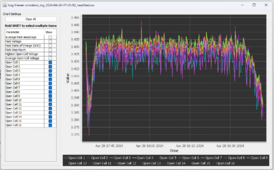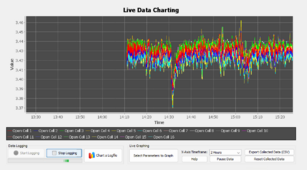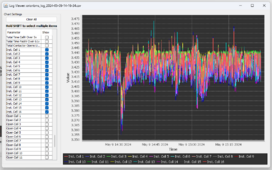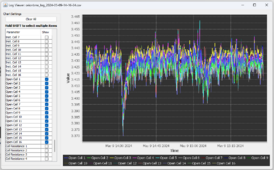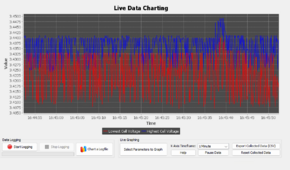hwy17
Anti-Solar Enthusiast
I am creating a new thread for the further discussion of this concept I have been working on. I am putting it into daily use now on a solar cycled open loop 48v whole house Lifepo4 battery bank so I'll start sharing the results here, if I find anything interesting.
What is the 55v method?
This involves setting all charge parameters to a single voltage. For now, I am using 55v/3.437, it's a round number and it seems like it might be the best compromise. The ideal number could be somewhere else close, 54.9, 55.1v, but it's surely in between 54 and 56v. (Or 27.5v for 24v batteries / 13.75 volts for 12v).
Bulk: 55v
Absorb: 55v
Float: 55v
Balance: Starting at 3.437, and never below 3.437
Why is the 55v method?
A single voltage charging scheme primarily solves two problems:
1. Absorption termination presents a conundrum to a solar system. The charger cannot inherently tell how much of it's output is going to loads vs. battery, so it cannot intelligently terminate the absorption process based on amperage. Either it has to fall back on a timer and just assume that after a set period of time absorption is finished, or communications have to be established between the BMS and the charger so that the BMS can inform the charger when the battery is done absorbing. With a single voltage charging scheme, it does not matter if the charger never exits absorbing, because absorbing at 55v is the same as floating at 55v.
2. Balancing schemes that depend on a high absorption voltage for their balancing pressure are vulnerable to a shortage of balancing activity duration. They are only provided a limited window each day at this absorption voltage in order to get their balancing done. At solar C rates, the absorption window could even be as short as 15 minutes per day. Rather than trying to address this shortcoming with active balancers and ever higher balancing currents in order to squeeze the balancing activity into this window, with a single voltage charging scheme we give the battery balancing pressure for the entire full voltage day (absorb + float duration).
What is wrong with the 55v method?
A single voltage charging scheme primarily causes two problems:
1. At lower bulk and absorption voltages, the maximum charge rate will be reduced. As established by OGG and others, the SOC in the battery at the end of the bulk will be significantly less at a lower voltage, adding to the effect of extending the absorption period. It is possible in some system designs that this limitation could result in the battery bank not accepting the charge as fast as the solar can make it, but I believe at typical solar C rates this is might not be a problem, and whatever charge does not make it into the battery during bulk has the entire rest of the day at the same voltage to get in there. There is no need to rush because the float is not gonna let off the gas.
2. The float charge is naturally going to be higher than is ideal for the chemistry, because of the compromise we are making between it and the bulk/absorb. You would not want to use 3.437 on a continuously floated battery as in a UPS or standby application. I believe that two factors are going to allow the higher float to be acceptable in solar cycled systems: First, since we are bulking and absorbing at a lower voltage than usual, we are not cramming the charge in, and this should leave a bit of vacancy in the chemistry to accept the rest of the day's over voltage. Secondly, our float is naturally limited to a maximum of maybe 6-8 hours due to the daily solar cycle, and we are expecting loads to immediately relieve the pressure at the end of that. This balancing act of undercharging and overcharging may allow the compromise to work without harming the cells. But we wouldn't really know until someone has life cycled a battery this way, so this will probably be the primary ongoing topic of theoretical debate about the method.
What is the 55v method?
This involves setting all charge parameters to a single voltage. For now, I am using 55v/3.437, it's a round number and it seems like it might be the best compromise. The ideal number could be somewhere else close, 54.9, 55.1v, but it's surely in between 54 and 56v. (Or 27.5v for 24v batteries / 13.75 volts for 12v).
Bulk: 55v
Absorb: 55v
Float: 55v
Balance: Starting at 3.437, and never below 3.437
Why is the 55v method?
A single voltage charging scheme primarily solves two problems:
1. Absorption termination presents a conundrum to a solar system. The charger cannot inherently tell how much of it's output is going to loads vs. battery, so it cannot intelligently terminate the absorption process based on amperage. Either it has to fall back on a timer and just assume that after a set period of time absorption is finished, or communications have to be established between the BMS and the charger so that the BMS can inform the charger when the battery is done absorbing. With a single voltage charging scheme, it does not matter if the charger never exits absorbing, because absorbing at 55v is the same as floating at 55v.
2. Balancing schemes that depend on a high absorption voltage for their balancing pressure are vulnerable to a shortage of balancing activity duration. They are only provided a limited window each day at this absorption voltage in order to get their balancing done. At solar C rates, the absorption window could even be as short as 15 minutes per day. Rather than trying to address this shortcoming with active balancers and ever higher balancing currents in order to squeeze the balancing activity into this window, with a single voltage charging scheme we give the battery balancing pressure for the entire full voltage day (absorb + float duration).
What is wrong with the 55v method?
A single voltage charging scheme primarily causes two problems:
1. At lower bulk and absorption voltages, the maximum charge rate will be reduced. As established by OGG and others, the SOC in the battery at the end of the bulk will be significantly less at a lower voltage, adding to the effect of extending the absorption period. It is possible in some system designs that this limitation could result in the battery bank not accepting the charge as fast as the solar can make it, but I believe at typical solar C rates this is might not be a problem, and whatever charge does not make it into the battery during bulk has the entire rest of the day at the same voltage to get in there. There is no need to rush because the float is not gonna let off the gas.
2. The float charge is naturally going to be higher than is ideal for the chemistry, because of the compromise we are making between it and the bulk/absorb. You would not want to use 3.437 on a continuously floated battery as in a UPS or standby application. I believe that two factors are going to allow the higher float to be acceptable in solar cycled systems: First, since we are bulking and absorbing at a lower voltage than usual, we are not cramming the charge in, and this should leave a bit of vacancy in the chemistry to accept the rest of the day's over voltage. Secondly, our float is naturally limited to a maximum of maybe 6-8 hours due to the daily solar cycle, and we are expecting loads to immediately relieve the pressure at the end of that. This balancing act of undercharging and overcharging may allow the compromise to work without harming the cells. But we wouldn't really know until someone has life cycled a battery this way, so this will probably be the primary ongoing topic of theoretical debate about the method.
Last edited:




